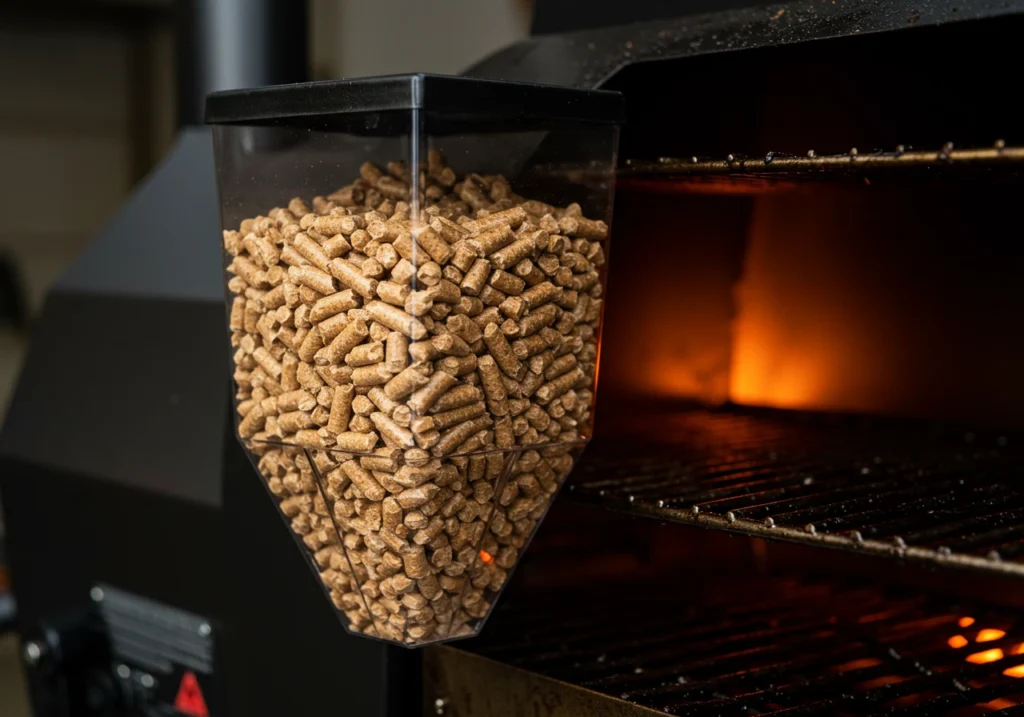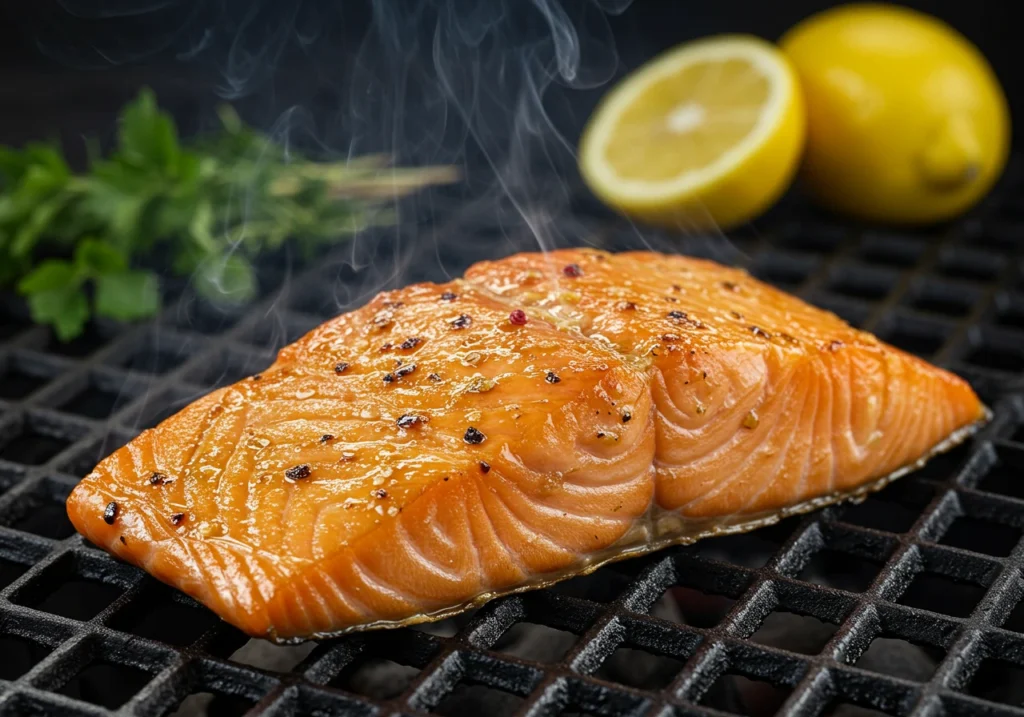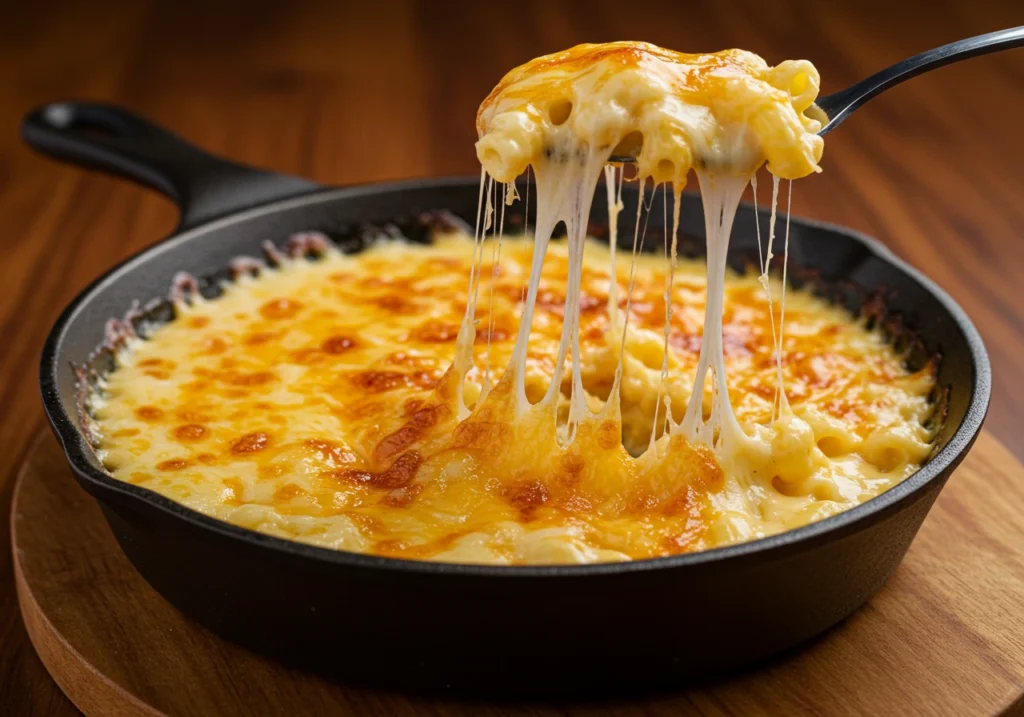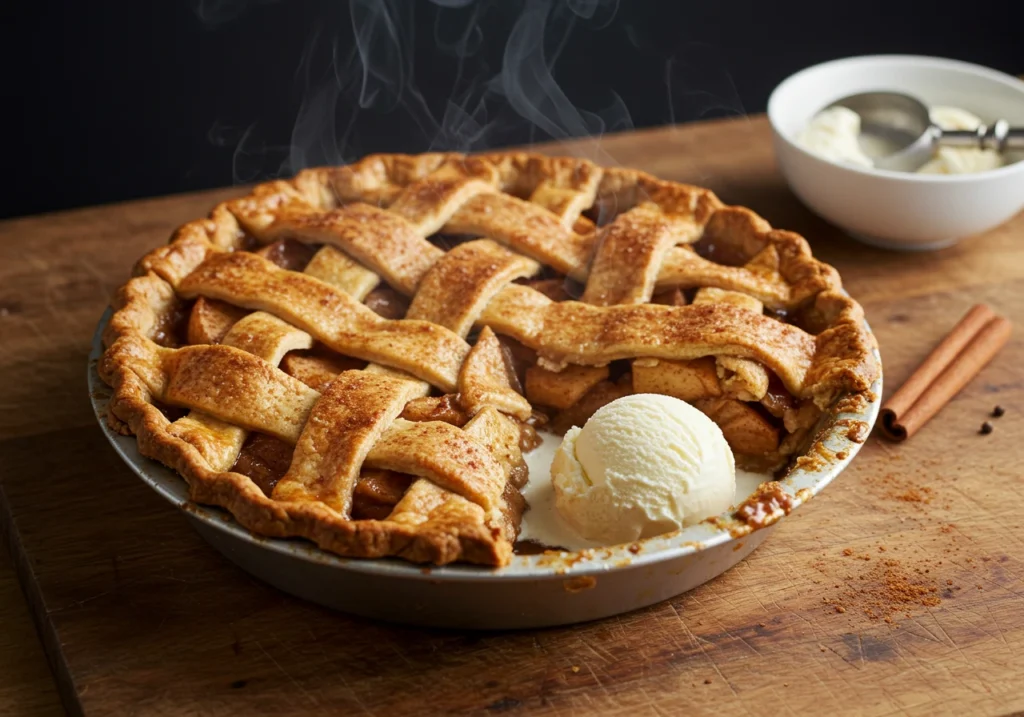Pellet Smoker Recipe Guide: Mastering the Art of Wood-Fired Cooking
Pellet smokers have changed the game for BBQ enthusiasts, providing an easy and effective way to achieve rich, smoky flavors with precise temperature control. Whether you’re a backyard cook or a seasoned pitmaster, understanding how to harness the power of wood pellets can take your dishes to the next level.
This guide will cover everything from choosing the right wood pellets and essential tools to classic and innovative Pellet Smoker Recipe. Plus, I’ll be sharing my personal experience with smoking different dishes, including brisket, salmon, and even dessert! So, let’s fire up the smoker and dive right in.
Part 1: Understanding Pellet Smokers
What is a Pellet Smoker and Why Should You Use One?
Pellet smokers, also known as pellet grills, use compressed wood pellets as fuel to create consistent heat and smoke. Unlike traditional charcoal or offset smokers, they offer precise temperature control, making them an excellent choice for both beginners and experts.
What makes them unique?
- Ease of Use: No need for constant babysitting like with a charcoal smoker.
- Consistent Temperature: Set your temperature, and the smoker does the rest.
- Wood Flavor Variety: You can mix and match different wood pellets to customize the taste.
- Versatility: Smoke, roast, bake, or grill all in one machine!
How Does a Pellet Smoker Work?
At its core, a pellet smoker is a convection oven fueled by wood pellets. Here’s how it works:
- Pellets are fed from the hopper into a burning chamber via an auger.
- A fan distributes the heat and smoke evenly inside the cooking chamber.
- A digital controller maintains the set temperature by regulating pellet feed and airflow.
This automated process eliminates the guesswork and ensures perfectly smoked meats, vegetables, and even baked goods.
Types of Pellet Smokers
Pellet smokers come in different sizes and styles. Before you buy, consider:
- Portable Pellet Smokers – Great for tailgating or camping.
- Mid-Sized Models – Ideal for home BBQ enthusiasts.
- Competition-Level Smokers – Feature larger cooking spaces and more precise controls.
No matter which type you choose, investing in a quality smoker will enhance your cooking experience.
Common Pellet Smoker Myths Debunked
“Pellet smokers don’t produce enough smoke.” – Actually, modern models allow you to adjust smoke levels for a deeper flavor.
“They are just like gas grills.” – Unlike gas grills, pellet smokers impart real wood-fired flavor to your food.
“Pellet smokers are only good for low and slow cooking.” – Many models reach high temperatures, allowing you to grill and sear as well!

Part 2: Essential Tools and Accessories for Pellet Smoking
Pellet smokers are incredible for delivering delicious, smoky flavors with minimal effort. But to truly master Pellet Smoker Recipe having the right tools and accessories can make all the difference. Whether you’re a seasoned BBQ enthusiast or just starting, investing in high-quality equipment will ensure consistency and ease in your smoking experience.
Must-Have Tools for Pellet Smoker Cooking
1. Digital Meat Thermometer 🥩
Pellet smokers do an excellent job of maintaining temperature, but a reliable meat thermometer is essential for precise internal readings. Look for:
- Instant-read thermometers for quick checks.
- Wireless probes for remote monitoring without lifting the lid.
2. Grill Cover 🏡
A quality grill cover protects your pellet smoker from moisture, dust, and debris. Since pellet grills contain electrical components, keeping them dry is crucial for longevity.
3. Pellet Storage Container 🌾
Wood pellets absorb moisture, which can impact their burn efficiency. A sealed container or a pellet storage bucket with a lid keeps your fuel dry and ready to use.
4. Cleaning Kit 🧹
Maintaining your smoker ensures its longevity. A basic cleaning kit should include:
- Grill brushes to clean the grates.
- Vacuum or ash bucket to remove pellet residue.
- Scraper to clear grease buildup.
5. Drip Pans & Grease Traps 🔥
Drip pans prevent flare-ups and make cleanup easier by catching grease and food drippings. Some pellet smokers come with a grease management system, but having disposable liners can save time.
Enhancing Flavor with Smoking Accessories
Wood Pellet Varieties 🌲
Different wood pellets provide unique flavors to your food. Mixing and matching them can elevate your dishes:
- Hickory – Strong, smoky flavor, great for beef and poultry.
- Apple – Slightly sweet, perfect for chicken and fish.
- Mesquite – Bold, earthy, and ideal for red meats.
Smoke Tubes & Boxes 🚀
Want extra smoky flavor? A smoke tube can generate additional smoke inside your pellet smoker. Fill it with your favorite pellets, light it up, and let the magic happen!
Part 3: Preparing Your Pellet Smoker for Success
Before diving into mouthwatering Pellet Smoker Recipe it’s crucial to prepare your smoker properly. A well-maintained and correctly prepped pellet smoker ensures consistent temperatures, optimal smoke flavor, and perfectly cooked food every time.
Step 1: Cleaning and Maintenance
A clean smoker not only enhances flavor but also extends the lifespan of your unit. Before each cook:
✅ Empty the Ash Pan – Remove ash from the firepot to ensure efficient burning. A small vacuum helps speed up the process.
✅ Clean the Grease Tray – Built-up grease can lead to flare-ups. Wipe it down after every cook.
✅ Brush the Grill Grates – Use a high-quality grill brush to remove leftover food particles and prevent sticking.
Step 2: Preheating Your Pellet Smoker
Preheating is essential to allow the smoker to stabilize at the right temperature.
Turn on the smoker and set it to the desired temperature.
Let it heat for at least 10-15 minutes before placing food inside.
Check for even heat distribution using a grill thermometer.
Step 3: Choosing the Right Pellets
Pellets affect both the smoke profile and heat efficiency. Some great options include:
🌲 Hickory – Bold and smoky, great for beef.
🍏 Applewood – Slightly sweet, perfect for poultry and fish.
🔥 Mesquite – Intense smokiness, best for red meat.
Step 4: Managing Smoke Output
For the best flavor, avoid excessive white smoke. Instead, aim for thin, blue smoke, which indicates clean-burning pellets and proper airflow. Adjust the smoke settings based on the recipe requirements.
Final Tips Before You Start Cooking
Always keep a spare bag of pellets handy to prevent running out mid-cook.
Use a water pan in the smoker to maintain moisture and prevent food from drying out.
If your smoker has a “super smoke” mode, use it for an extra burst of flavor.
Part 4: Selecting the Right Wood Pellets for Flavorful Smoking
When it comes to Pellet Smoker Recipe, your choice of wood pellets plays a crucial role in determining the flavor profile of your food. Unlike gas or charcoal grills, pellet smokers infuse food with the rich aroma of real wood, enhancing taste and texture. But with so many options, which wood should you choose? Let’s break it down!
Understanding Wood Pellets and Their Impact
Wood pellets are compressed sawdust that burns efficiently to produce consistent heat and smoke. The type of wood you use can make a noticeable difference, whether you’re cooking juicy brisket, tender chicken, or smoked vegetables.
Here’s a guide to some of the most popular wood pellet flavors and the foods they complement best:
Best Wood Pellets for Meat & Vegetables
| Wood Type | Flavor Profile | Best For |
|---|---|---|
| Hickory | Strong, bold, slightly sweet smoke | Beef, ribs, brisket, turkey |
| Applewood | Mild, slightly sweet, fruity aroma | Chicken, pork, fish, vegetables |
| Mesquite | Intense, earthy, slightly bitter | Steak, game meats, burgers |
| Cherry | Mild, fruity, and slightly tart | Chicken, pork, lamb, salmon |
| Pecan | Nutty, slightly sweet, subtle smoke | Poultry, fish, baked goods |
| Oak | Medium, clean smoke with a hint of sweetness | Beef, lamb, roasted veggies |
| Maple | Sweet, delicate, smooth | Pork, chicken, seafood, bacon alternatives |
Blending Wood Pellets for Unique Flavors
Many BBQ enthusiasts mix different pellet flavors to create custom smoke profiles. Some great combinations include:
- Hickory + Cherry → A bold, smoky kick with a touch of sweetness (perfect for ribs).
- Apple + Pecan → Smooth, slightly sweet, and nutty (amazing for poultry).
- Mesquite + Oak → Strong, earthy smoke with a balanced finish (ideal for red meats).
Avoiding Low-Quality Pellets
Not all pellets are created equal! Look for:
100% natural hardwood (no fillers or binders).
Low ash production for a cleaner burn.
Dry, well-stored pellets to prevent moisture-related combustion issues.
Part 5: Preparing Your Pellet Smoker for Perfect Results
Before you fire up your Pellet Smoker Recipe, proper preparation is crucial to ensure consistent heat, optimal smoke infusion, and the best flavor results. A well-maintained smoker not only delivers better-tasting food but also extends the life of your grill. Here’s how to prep your pellet smoker like a pro.
Step 1: Cleaning the Smoker for Peak Performance
🔥 Remove Ash and Grease Buildup
Ash accumulation can restrict airflow and reduce efficiency. After each cook:
Empty the ash pan or use a vacuum for quick cleanup.
Wipe the grease tray with a paper towel or degreaser to prevent flare-ups.
Brush the grill grates to remove food residue.
🔥 Check the Firepot and Burn Chamber
Pellets leave behind small amounts of ash, which can clog airflow if not cleared. A simple brush-out before every cook helps maintain consistent burning.
Step 2: Preheating the Smoker
🔥 Why Preheating Matters
Just like an oven, preheating your pellet smoker allows it to reach the right cooking temperature, preventing temperature swings that affect cooking times.
Turn on the smoker and set it to the desired temp (225°F for low-and-slow, 350°F+ for grilling).
Let it heat up for 10-15 minutes with the lid closed to stabilize the temperature.
Check for even heat distribution using a grill thermometer.
🔥 Tip: If your smoker has a “super smoke” mode, activate it during preheating to boost smoke infusion!
Step 3: Pellet Check – The Right Fuel for the Right Flavor
🔥 Ensuring the Hopper is Full
Your pellet smoker relies on a steady feed of high-quality pellets to maintain temperature. Before cooking:
Check for moisture-free, fresh pellets (old or damp pellets won’t burn efficiently).
Top off the hopper to avoid running out mid-cook.
Use the right wood pellets for the recipe – mesquite for steak, applewood for chicken, etc.
🔥 Pro Tip: Store pellets in an airtight container to prevent moisture absorption.
Part 6: Classic Pellet Smoker Recipe
Pellet smokers excel at low-and-slow cooking, allowing you to infuse rich, smoky flavors into meats, fish, and more. Whether you’re craving succulent brisket, fall-apart pulled pork, or delicate smoked salmon, these classic Pellet Smoker Recipe will take your BBQ game to the next level.
Smoked Brisket: The King of BBQ
Smoked brisket is the ultimate test of patience and technique, but the deep, smoky flavor and tender texture are well worth the wait!
Ingredients
- 1 whole beef brisket (10-12 lbs)
- 2 tbsp salt
- 2 tbsp black pepper
- 1 tbsp garlic powder
- 1 tbsp paprika (optional for extra color)
Preparation: Trimming and Seasoning
Trim excess fat, leaving about ¼ inch for moisture retention.
Mix the seasoning and coat the brisket generously on all sides.
Let it rest for at least 1 hour (or overnight in the fridge) to absorb flavors.
Smoking Process: Low and Slow Perfection
Preheat your pellet smoker to 225°F.
Place the brisket fat-side up on the grill grates.
Smoke for 6-8 hours, spritzing with apple juice or broth every 2 hours.
Once the internal temperature reaches 165°F, wrap it in butcher paper or foil.
Continue smoking until it reaches 195-203°F (this takes another 5-6 hours).
Resting and Serving for Maximum Juiciness
Let the brisket rest for at least 1 hour, wrapped, to retain moisture.
Slice against the grain for the most tender bites.
Serve with BBQ sauce, pickles, and fresh bread for a classic Texas-style feast!
Smoked Salmon: Light, Healthy, and Flavorful
If you think a pellet smoker is only for meats, think again! Smoked salmon is rich, buttery, and infused with a delicate wood-fired aroma.
Ingredients
- 4 salmon fillets (skin-on for best results)
- 1 tbsp olive oil
- 1 tsp sea salt
- ½ tsp black pepper
- 1 tsp fresh dill, chopped
- Zest of 1 lemon
Preparation: Simple Yet Effective
Pat the salmon dry to help the smoke adhere.
Brush with olive oil, then season with salt, pepper, and lemon zest.
Let it sit for 15 minutes while preheating the smoker.
Smoking Process: Low-Temp Perfection
Set smoker to 180°F for gentle smoking.
Place salmon skin-side down on a cedar plank or grill grates.
Smoke for 2 hours or until the salmon reaches 140°F (should be flaky).
Serving Suggestions for Smoked Salmon
Pair with a fresh salad, roasted vegetables, or serve over toast.
Add a squeeze of lemon and a dollop of dill sauce for extra brightness.

Part 7: Innovative Pellet Smoker Recipe
While most people associate pellet smokers with meats, their versatility extends far beyond brisket and ribs. From comforting smoked mac and cheese to flavorful wood-fired vegetables, these innovative recipes will take your pellet smoker cooking to the next level.
Smoked Mac and Cheese: Creamy, Smoky, and Irresistible
Who knew that a pellet smoker could turn this classic comfort food into a smoky, cheesy masterpiece? Smoked mac and cheese delivers an extra layer of depth and richness that’s impossible to achieve in a regular oven.
Ingredients
- 1 lb elbow macaroni
- 4 tbsp butter
- 3 cups shredded cheddar cheese (or a mix of gouda, mozzarella, and smoked cheddar)
- 1 cup milk
- 1 cup heavy cream
- 1 tsp salt
- ½ tsp black pepper
- ½ tsp smoked paprika
- ½ cup breadcrumbs (panko works best)
- ½ cup grated Parmesan cheese
Preparation: Making the Ultimate Cheese Sauce
Cook the macaroni in salted boiling water until al dente. Drain and set aside.
Melt butter in a saucepan, then whisk in the milk and heavy cream.
Slowly add shredded cheese, stirring until melted and smooth.
Season with salt, black pepper, and smoked paprika for extra depth.
Combine the pasta and cheese sauce, mixing well.
Smoking Process: The Secret to Creamy, Smoky Perfection
Preheat your pellet smoker to 225°F.
Transfer mac and cheese to a cast-iron skillet or baking dish.
Top with a mixture of breadcrumbs and Parmesan cheese for a crunchy crust.
Smoke for 1 hour, allowing the cheese to absorb that delicious wood-fired flavor.
For extra crispiness, crank the heat to 350°F for the last 10 minutes.
Serving Suggestions for Smoked Mac and Cheese
As a side dish – Pairs perfectly with smoked brisket or ribs.
As a main course – Top with smoked bacon bits or shredded BBQ chicken for a full meal.
Next-level leftovers – Use smoked mac and cheese to stuff burgers or grilled sandwiches!

Smoked Vegetables: A Flavorful, Healthy Twist
Forget boring, bland steamed vegetables—smoking vegetables brings out their natural sweetness while infusing them with delicious wood-fired aromas. Whether you’re serving them as a side dish or tossing them in a salad, smoked veggies are a game-changer!
Ingredients
- 2 bell peppers, sliced
- 1 zucchini, sliced into rounds
- 1 cup mushrooms, halved
- 1 red onion, sliced
- 2 tbsp olive oil
- 1 tsp sea salt
- ½ tsp black pepper
- ½ tsp garlic powder
- ½ tsp smoked paprika
- 1 tsp dried Italian herbs (or fresh thyme/rosemary)
Preparation: Seasoning for Maximum Flavor
Wash and chop vegetables into even-sized pieces.
Toss veggies in olive oil to help the seasonings adhere.
Sprinkle with salt, pepper, garlic powder, paprika, and herbs for a bold, smoky flavor.
Smoking Process: Bringing Out the Best in Vegetables
Set your pellet smoker to 250°F for a gentle roast.
Arrange vegetables on a grill pan or smoker-safe tray to prevent them from falling through the grates.
Smoke for 45 minutes, tossing halfway through for even cooking.
Check for tenderness—vegetables should be slightly charred but not mushy.
Serving Suggestions for Smoked Vegetables
As a side dish – Pairs well with smoked chicken, steak, or salmon.
In a salad – Toss smoked veggies with arugula, feta, and balsamic glaze for a grilled salad.
On pizza or pasta – Adds depth and smokiness to classic Italian dishes.
Part 8: Dessert on a Pellet Smoker – Smoked Apple Pie
If you think a pellet smoker is just for meats and savory dishes, think again! Smoked desserts bring a whole new level of depth and richness, blending sweet flavors with a subtle, smoky aroma. One of the best desserts you can make is Smoked Apple Pie—a comforting classic with an irresistible wood-fired twist.
Smoked Apple Pie: A Sweet and Smoky Delight
The gentle heat of a pellet smoker gives apple pie a perfectly crisp crust and a deep caramelized flavor. The mild smokiness enhances the warmth of cinnamon and brown sugar, making this pie unforgettable Pellet Smoker Recipe .
Ingredients
- 6 medium apples (Granny Smith or Honeycrisp, peeled and sliced)
- ½ cup granulated sugar
- ¼ cup brown sugar
- 1 tsp ground cinnamon
- ½ tsp nutmeg
- 1 tbsp cornstarch
- 1 tsp vanilla extract
- 1 tbsp lemon juice
- 2 tbsp butter (cut into small cubes)
- 1 pre-made or homemade pie crust
- 1 egg (for egg wash)

Preparation: Assembling the Pie
Preheat your pellet smoker to 350°F.
Toss the sliced apples with sugar, cinnamon, nutmeg, cornstarch, vanilla, and lemon juice in a large bowl. Let it sit for 10 minutes.
Roll out the pie crust and place it in a cast-iron skillet or smoker-safe pie dish.
Fill with the apple mixture and dot with butter pieces.
Cover with the top crust, crimp the edges, and cut small slits for steam to escape.
Brush with egg wash for a golden finish.
Smoking Process: Achieving That Perfect Crust
Place the pie in the preheated smoker and bake for 50-60 minutes.
Rotate halfway through to ensure even cooking.
Check for doneness when the crust is golden brown, and the apples are bubbling.
Let it rest for 15 minutes before slicing to allow the juices to set.
Serving Suggestions for Smoked Apple Pie
Top with a scoop of vanilla ice cream for a hot-and-cold contrast.
Drizzle with caramel sauce for extra indulgence.
Pair with a cup of smoked coffee or tea for a cozy dessert experience.


1 thought on “Ultimate Pellet Smoker Recipe Guide: Best Dishes to Try Today!”